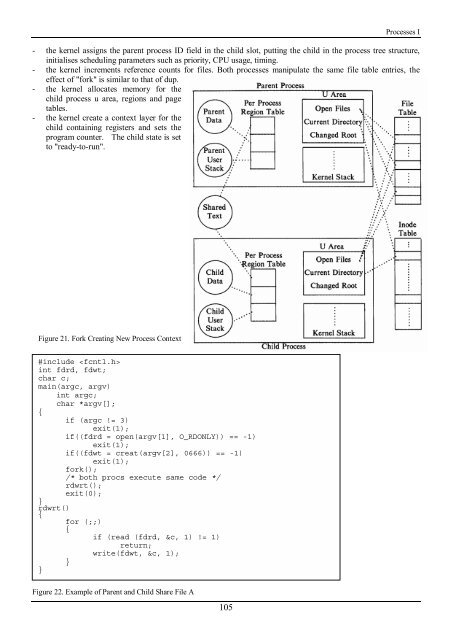You also want an ePaper? Increase the reach of your titles
YUMPU automatically turns print PDFs into web optimized ePapers that Google loves.
Processes I<br />
- <strong>the</strong> kernel assigns <strong>the</strong> parent process ID field in <strong>the</strong> child slot, putting <strong>the</strong> child in <strong>the</strong> process tree structure,<br />
initialises scheduling parameters such as priority, CPU usage, timing.<br />
- <strong>the</strong> kernel increments reference counts for files. Both processes manipulate <strong>the</strong> same file table entries, <strong>the</strong><br />
effect of "fork" is similar to that of dup.<br />
- <strong>the</strong> kernel allocates memory for <strong>the</strong><br />
child process u area, regions and page<br />
tables.<br />
- <strong>the</strong> kernel create a context layer for <strong>the</strong><br />
child containing registers and sets <strong>the</strong><br />
program counter. The child state is set<br />
to "ready-to-run".<br />
Figure 21. Fork Creating New Process Context<br />
#include <br />
int fdrd, fdwt;<br />
char c;<br />
main(argc, argv)<br />
int argc;<br />
char *argv[];<br />
{<br />
if (argc != 3)<br />
exit(1);<br />
if((fdrd = open(argv[1], O_RDONLY)) == -1)<br />
exit(1);<br />
if((fdwt = creat(argv[2], 0666)) == -1)<br />
exit(1);<br />
fork();<br />
/* both procs execute same code */<br />
rdwrt();<br />
exit(0);<br />
}<br />
rdwrt()<br />
{<br />
for (;;)<br />
{<br />
if (read (fdrd, &c, 1) != 1)<br />
return;<br />
write(fdwt, &c, 1);<br />
}<br />
}<br />
Figure 22. Example of Parent and Child Share File A<br />
105
















